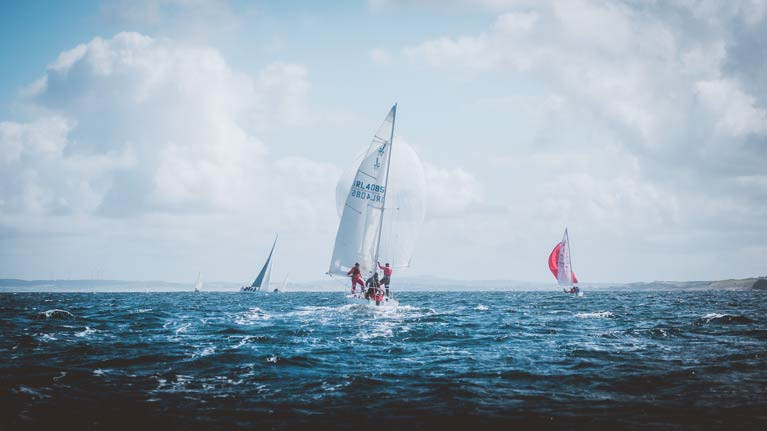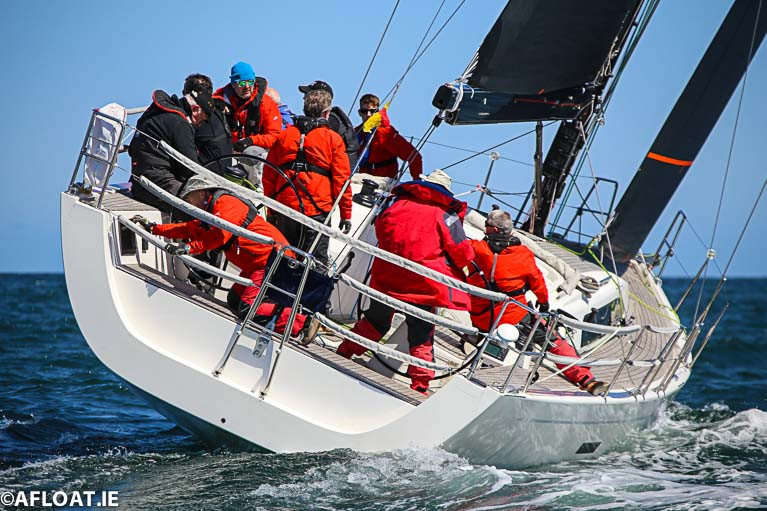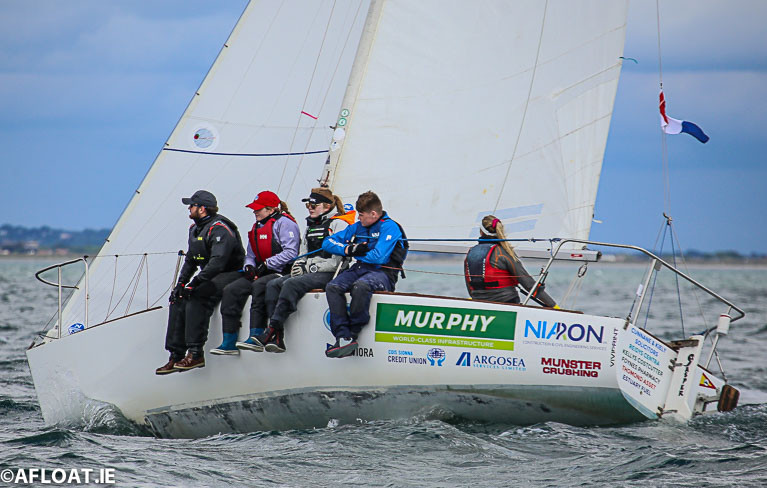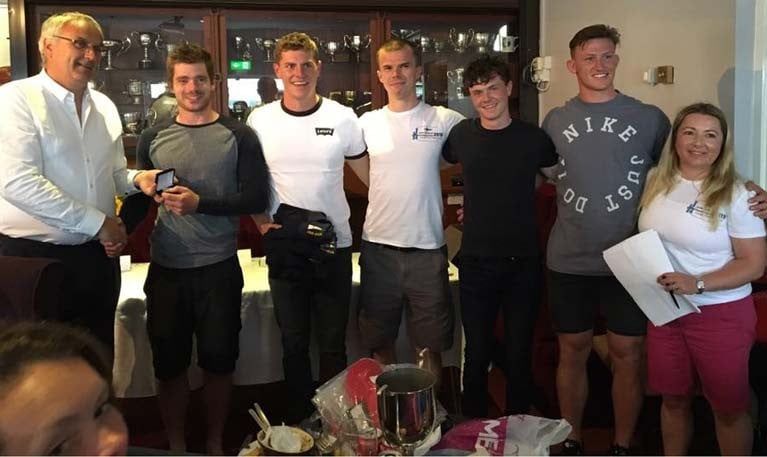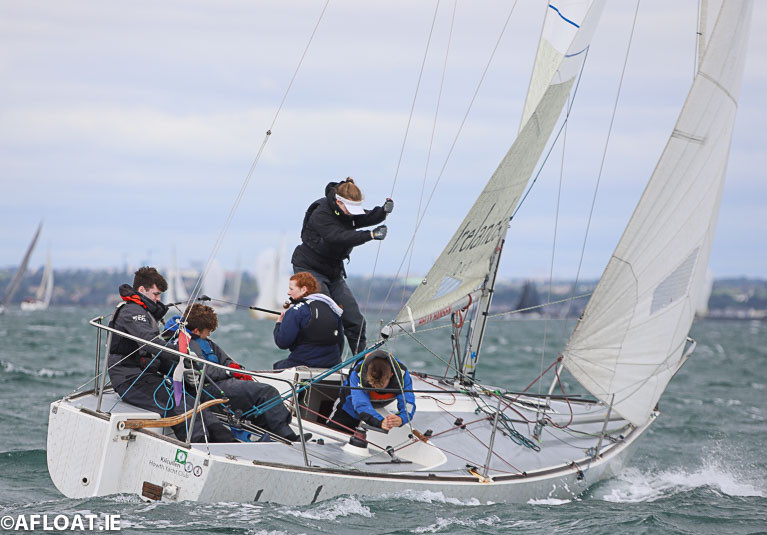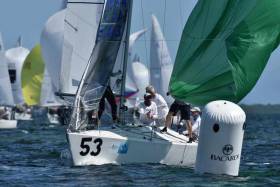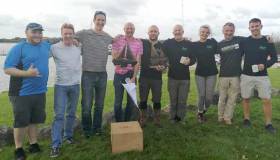Displaying items by tag: J24
Every sport sees it happen. Young enthusiastic kids who can't get enough training, competing, fitness, drills, and dreams of making it big writes Paul O'Hare of Rush Sailing Club.
Many then drift away from the sport they loved as they get into their late teens and 20's. Sport gets replaced with studies, college, travel, partners, new careers, marriage, family, and maybe realising that they are not the next Cluxton, Keane, O'Driscoll, or Murphy. Finally, after 10 or 15 years, they get back to the sport they once loved, but now with their own kids.
In sailing, this is an all too familiar story as young sailors, tossed about on the seas of Ireland in single-handed Oppies, Toppers and Lasers, give up the sport during their adolescence. It's hard then to get back into a small dinghy when they are older, so many give up sailing altogether.
Well, the fine people at Rush Sailing Club in North County Dublin have watched this happen throughout the generations, from the club's inception in 1954 to the modern day. They've put together a plan to keep these young adults in the sport by making it exciting, inclusive, competitive and fun. Central to this drive is the club's acquisition of two J/24 racing keelboats. The club chose this popular and competitive boat with 5,500 boats sailing in 165 fleets throughout 110 countries. Crews range from four to six people, and the boat is an ideal all-rounder, offering exciting racing to experienced sailors but a safe introduction to novices (that's right, it has a keel so it won't capsize! Mostly). The boat can be trailered to events and is suitable for all kinds of weather.
 The new Rush Sailing Club J/24's look fast with their new paint job
The new Rush Sailing Club J/24's look fast with their new paint job
The team in Rush are lead by two 20-year old committee members, David Kelly (Sailing Sec) and Lauren O'Hare (Senior Instructor, SI). They are putting together a team racing schedule with the new boats and some other multi-crewed boats that the club own. Team racing draws in members of all ages as Rush family dynasties are pitted against each other. Novices will sail alongside seasoned veterans in a winner-takes-all season. In addition, young crews aim to compete around Ireland & the UK against other clubs in this highly competitive class. The club aims to boost sailing with competition on the water, enhancing the membership experience for all.
 Rush Sailing Club members collecting the boats in Southampton before their renovation
Rush Sailing Club members collecting the boats in Southampton before their renovation
The boats are aptly named 'Juvenile Delinquent' and 'Out of Control'. They were purchased second hand in Southampton at the start of the lockdown, and in typical RSC fashion, they were sourced, collected, gutted and restored by the club's members under the stewardship of Commodore David Kelly (senior). Sponsorship provided by local businesses and members allowed the club to put the boats on the water with zero cost to the membership!
So, if you've never sailed but would love to give it a try, or if you want to get back to sailing, or if you fancy a bit of high-octane competitive fun, then contact RSC, where a new sport, hobby and obsession awaits you.
J24 for Royal Cork Yacht Club Fleet
The Royal Cork Yacht Club at Crosshaven in Cork Harbour is buying a J24 keelboat to widen its fleet of club boats.
Funding for this is coming from the sale of two of its existing fleet of four 1720 sportsboats.
"To consolidate the club fleet and bring a broader offering, two of the four club 1720s have been sold back into the fleet," according to the club. "The remaining two boats are currently being revamped and made ready for the season ahead.
"With the proceeds, a deal is complete on a J24 and, once Covid restrictions allow, the boat will be brought to the club, allowing for a broader offering of boats for members both young and old."
The International J/24 Class Association (IJCA) and the Parkstone Yacht Club in Poole in Dorset have announced that the 2021 J/24 World Championship scheduled for September 26-October 1, 2021 has been cancelled.
It follows a previous decision to postpone the event until September as Afloat reported here.
The Organising Committee (OC) had hoped that it would be possible to hold the much-anticipated regatta this autumn. However, despite the encouraging progress that is being made toward the UK's recovery from the COVID-19 pandemic, it is clear that even if the UK lockdown continues in line with the UK Government's current timetable, there will continue to be uncertainty regarding International travel for some time.
Regatta Chairman Bryan Drake commented, "We know that this will cause a great deal of disappointment, not only to the OC who have worked hard for over four years to deliver a superb event but also to the J/24 community across the world. Both the OC and the J/24 crews were hoping that the pandemic would be behind us all by now so that we could have looked forward to a fabulous fortnight later this year, but there is too much uncertainty to make this viable."
The IJCA look forward to resuming World Championship sailing in 2022.
County Sligo's Mullaghmore Sailing Club hosted its annual regatta last weekend, as Afloat previewed here, with careful consideration of health and safety in accordance with Irish Sailing’s ‘Return to Sailing’ guidance.
While some of the normal onshore post-sailing activities had to be curtailed, there was a super turnout of 16 boats, and Mullaghmore extended a very warm welcome to all the visitors. Racing started with the Pier Head Trophy on Friday evening in good conditions. This was won by Sligo Yacht Club’s Colm O’Flaherty and his crew on the J24, Jana. Jana also took the SF trophy on Saturday in much more mixed weather – occasional sunshine was interspersed with very heavy rain and squalls which presented a real challenge to the crews.
Racing finished on a high on a sunny Sunday with a strong offshore breeze giving flat seas, fast sailing, and a colourful display of spinnakers over the bay. The final race was the Commodore’s Cup which was won by Ed Cody from Royal North of Ireland Yacht Club in his impressive RS Elite, Speedwell.
Under the IRC rating system which handicaps the boats based on their speed and adjusts them to ‘corrected time’, the overall standing after six races over three days was:
- Jana (Colm O’Flaherty, SYC)
- Jevan (Ken Draper, SYC)
- Speedwell (Ed Cody, RNIYC)
It was really encouraging to see so many younger sailors taking up the challenge of helming and crewing the J24 class boats, with recent training programmes in both MSC and SYC paying dividends. Sligo’s Lady Caroline won under 25 class with an all-female crew, with Mullaghmore’s Black Pearl coming in second.
MSC Commodore, Michal Czubala, presented the results and individual race prizes outside the Pier Head after racing on Sunday, and congratulated all the sailors who took part in the regatta. He also thanked the support team, in particular Brian Matthews who came from Dublin to act as Race Officer for the weekend.
MSC has very recently signed up to the 20x20 Club Charter – a national initiative to support and promote women and girls in sports clubs. The 2020 Regatta was a significant milestone, as there were 3 boats with ladies at the helm, and more than 25% of the crew across the competing boats were female – the club is looking to build on this in coming years.
In a year when so many events and activities have been cancelled due to COVID-19 considerations, MSC has been making a big effort to get people on the water in a safe manner. Support from long-standing as well as the many new members was terrific. Club racing will continue for the remainder of the season. The junior sailing programme, which is running on shortened hours and reduced numbers has been fully booked so far, with limited places available for the next three weeks.
How Can Keelboat Racing Work with Social Distancing?
Olympic helmsman, professional sailor and coach Mark Mansfield takes a look at how it may be possible to return to keelboat racing while maintaining social distance onboard.
The latest Government five-phase programme appears to allow the reinstatement of boating and sailing from May the 18th, under certain restrictions.
The RNLI and Coastguard will likewise need to lift their advisory notice as well for this to happen.
Irish Sailing is liaising with the yacht clubs in Ireland and the Government to get clarity on specific aspects of this five-phase plan. In the interim, commencing racing appears to be positioned in Phase 3, which would begin on June the 29th but many sailors are asking; how can this happen under the requirement to also socially distance ourselves from others?
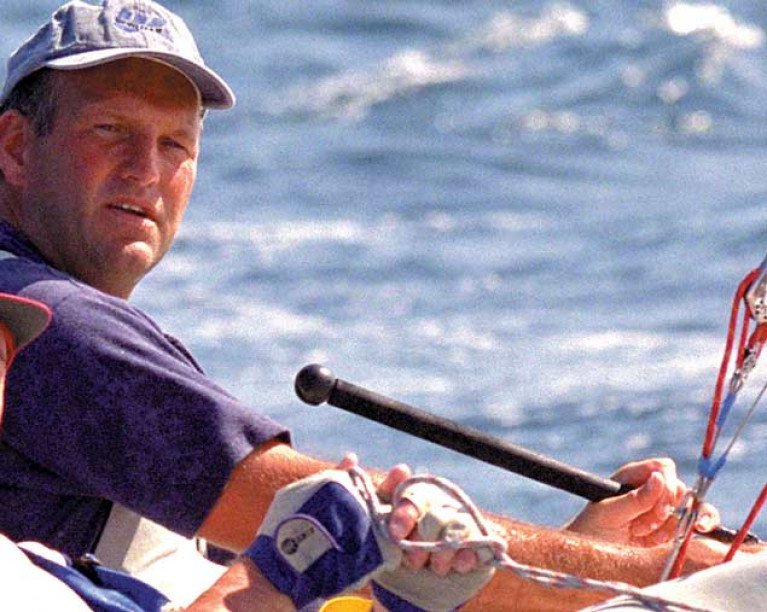 Article author Mark Mansfield sailed the Star keelboat for Ireland at four Olympic Regattas between 1996 and 2004. He is a multi-class Irish keelboat champion
Article author Mark Mansfield sailed the Star keelboat for Ireland at four Olympic Regattas between 1996 and 2004. He is a multi-class Irish keelboat champion
Other sports are also in the same situation with resumption to training planning on commencing in Phase 2 in early June and some matches in Phase 3. Team sports like soccer, Gaelic, hockey, basketball and others have further complications in that they compete directly against opposition at close quarters.
Luckily in sailing, though we are a team sport, our opposition usually is quite a bit away from us. It is therefore in our own hands how, on boats, we can keep our distance when racing. The following are my thoughts on how this can happen successfully, keeping our sport going in these difficult times.
Dinghies that rely on rescue boats when capsized, and two-person dinghies and smaller keelboats will have additional challenges. However, for the purposes of this article, I will concentrate on larger keelboats that have engines to allow them to look after themselves in the event of an emergency.
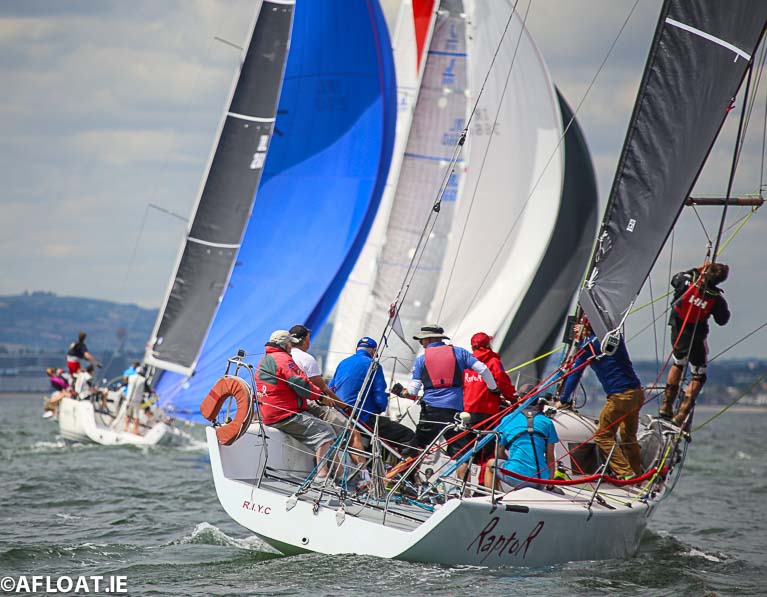 Class One boats approach a leeward mark on Dublin Bay in 2019 Photo: Afloat
Class One boats approach a leeward mark on Dublin Bay in 2019 Photo: Afloat
Fully crewed or shorthanded?
Though there are other options around bubbles, family crew and the like, clearly it will be challenging to sail fully crewed for the first couple of months and still keep the required space between each other. The sight of 8 bodies huddled together on the rail while going upwind on a 35-foot cruiser-racer would not only be regarded as unsafe but irresponsible and would send all the wrong messages.
So, at what crewing levels could racing happen and still keep close to the permitted social distancing levels?
It is possible to specify a max crew level for different sized boats.
Different sized boats have different crewing needs. An SB20 sportsboat, for example, does not need the same crew numbers as a 42-footer. So what crew numbers would be required on different sized boats. Here is my estimate:
- Up to 26 footers 3 max per boat – Only 2 allowed to sit over the side
- Over 26 foot and up to 31 foot – Max of 4 crew – only 2 allowed to sit over the side
- Over 31 foot and up to 36 foot – Max 5 crew – only 2 allowed to sit over the side
- Over 36 foot and up to 41 foot – Max 6 crew – only 3 allowed to sit over the side
- Over 41 foot and up to 46 foot – Max 7 crew and only 4 allowed to sit over the side
And so on in 5-foot sized increases.
An amendment to The Notice of Race (NOR) could be inserted for events to make these reduced numbers a requirement, while we still have these restrictions due to COVID 19.
Is this enough crew to race boats with spinnakers?
In the Fastnet Race in 2019, There were 65 entries in the Two-handed class, ranging from 45 footers, down to 30 footers. Most boats were in the 35-foot size range and used spinnakers. Yes they all would have autopilots, and that effectively gives you an extra pair of hands doing sail changes, but that still would mean that they would have had two less crew than my crew size thoughts above.
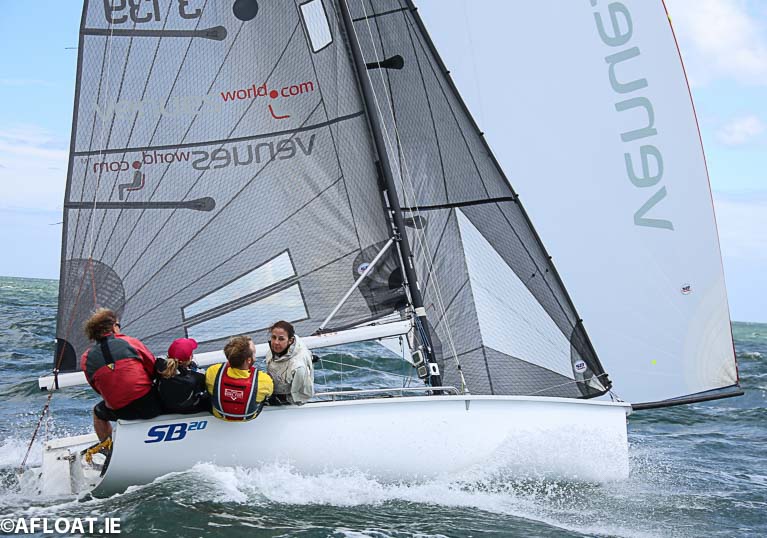 An SB20 racing under spinnaker in strong breeze with a crew of four on Dublin Bay Photo: Afloat
An SB20 racing under spinnaker in strong breeze with a crew of four on Dublin Bay Photo: Afloat
SB20
Certain classes, such as the SB20, would still find it challenging to keep a distance with 3 on board, and having spoken to the class, they could see a possibility, if required, to sail with just 2 crew, particularly in light winds. In stronger winds, they may wish to just sail without spinnakers.
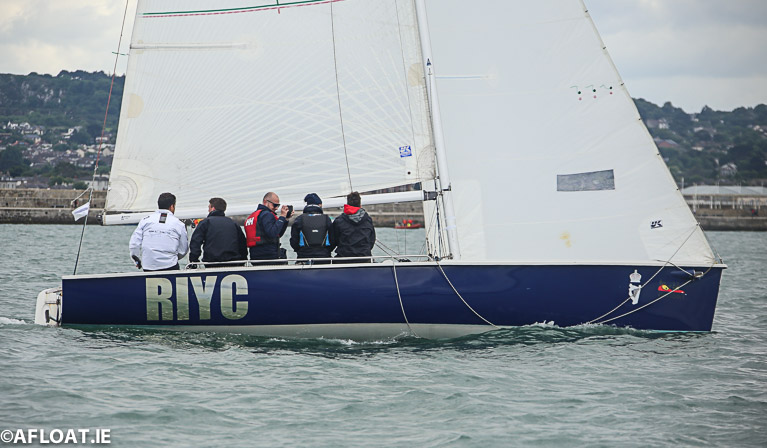 A 1720 keelboat with a crew of five in Dun Laoghaire Harbour Photo: Afloat
A 1720 keelboat with a crew of five in Dun Laoghaire Harbour Photo: Afloat
1720
The 1720 class has also looked at this, and Class Captain Clive O'Shea told Afloat: "If required, the 1720 class is ideally situated to reduce numbers to allow social distancing while racing. Three crew can keep apart, and we still have the option to go with small spinnakers and small jibs, if needed."
So how would this happen on a typical small cruiser, like a J24 or a medium-sized cruiser-racer like a J109?
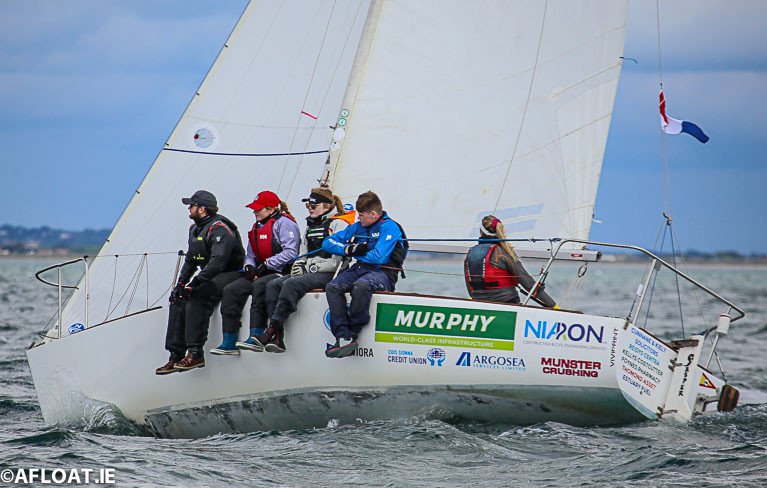 A J24 in racing mode Photo: Afloat
A J24 in racing mode Photo: Afloat
J24
Three crew could handle a J24; One is helming and trimming the main, one in the cockpit, and one on the bow. The Bowman stays forward of the shrouds; the cockpit person stays away from the helm, up by the hatch. It won't be all that easy, but 30-foot boats like Etchells have similar-sized sails and normally sail with 3.
 A fully crewed J109 on Dublin Bay (above) and a two-handed crew on the same model (below)
A fully crewed J109 on Dublin Bay (above) and a two-handed crew on the same model (below)
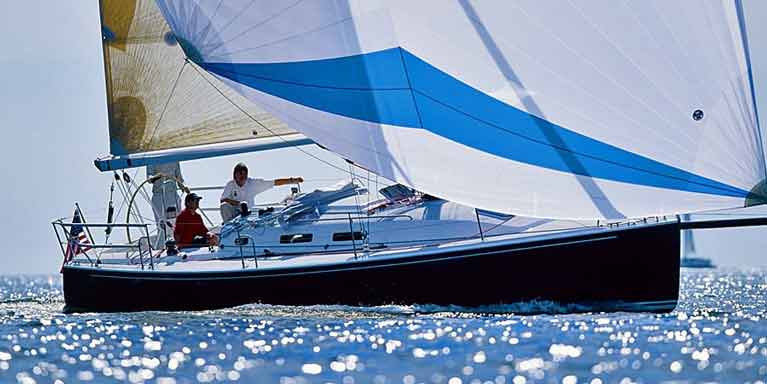
J109
Five on a J109; One on the wheel, staying back a bit. One in the cockpit is trimming the mainsheet but sitting well forward. Helm adjusts the traveller or leaves it in the centre. One sits in the hatch, or on top of the coachroof. The Jib Trimmer sits out, and during tacks, they pull in the new sheet while the Mainsheet Trimmer has let off the old jib sheet. The Bow person sits out forward of the shrouds; jib trimmer sits out to windward, 2 metres back from the Bowman. Downwind more room becomes available as both sides of the boat can accommodate the crew. Andrew Craig, Class Captain of the J109 class in Ireland, says, 'the J109 is well suited to shorthanded racing with the small jib and plenty of space for a reduced number to spread out. The Asymmetrical Spinnaker requires no pole which also makes shorthanded use possible in the right conditions'
White Sails & other options
For those with boats that are harder to sail, or if a crew is not that experienced, there is also the white sails (non-spinnaker) fleet to compete in, until fully crewed racing resumes.
Dublin Bay Sailing Club is the largest yacht racing club in the country with over 250 boats in 20 or so classes. Its Commodore, Johnathon Nicholson has this to add; "Along with the other clubs, DBSC is working with Irish Sailing to create a clear and safe path to get back on the water. We are currently investigating the practicalities of racing short haded with the appropriate physical distancing and when it could be introduced following the guidance provided by the government, Sport Ireland and Irish Sailing".
I appreciate there may be occasions during racing that crew get closer than planned for short periods. This is to be expected, but that will be the situation in virtually all sports that will likely be competing over the next few months. It is incumbent in our sport to come up with a plan to compete as safely as possible. This is just one option, and there will likely be others. Of course, this COVID-19 restriction could be tightened or eased during the next few months, and this proposed plan would then need to be looked at again. Reducing racing crew numbers also decreases the numbers that come back into the clubs allowing easier social distancing ashore.
Ultimately, however, as all sailors know, it is up to each individual skipper and crew to make their own decision about whether to go to sea or not.
2020 J/24 World Championship Postponed to September 2021
The International J/24 Class Association (IJCA) and the Parkstone Yacht Club in Poole United Kingdom has announced that the 2020 J/24 World Championship scheduled for September 12-18, 2020 will be postponed until September 24-October 2, 2021.
"With the current COVID-19 situation, it is looking very likely that the lockdown in the UK is going to carry on for some time yet, and at this time no indication has been given on how an exit policy will work," commented Bryan Drake, Regatta Chair. In addition to health and safety concerns, travel restrictions are likely to remain for some time as well as limited access to yacht clubs and marinas.
"The IJCA is extremely fortunate to have incredible World Championship hosts committed to the next four years that allow for this scheduling change," said Nancy Zangerle, IJCA Chair. "We hope this approach will allow our Class members and our hosts to plan accordingly. At this time, of greatest importance is the health and well-being of our J/24 family. We all long for the time when we can return to the water."
The IJCA World Council met via phone conference on April 20, and is able to confirm that all previously approved World Championships for 2020 through 2023 have agreed to shift as follows:
- 2021 World Championship, September 24-October 2, Parkstone Yacht Club, Poole UK
- 2022 World Championship, March (exact dates To Be Announced), Mendoza, Argentina
- 2023 World Championship, July 16-23, Corpus Christi, Texas USA
- 2024 World Championship, dates and exact location To Be Announced, Greece
Irish J/24 Fleet Embraces ICRA Under-25 Discount scheme
The Irish J/24 Fleet has answered the call from ICRA to offer 25% discount on entry fees for all U25 squads entering J/24 Events in 2020. Without hesitation, J/24 event hosts, Carrickfergus Sailing Club, Sligo Yacht Club, Foynes Yacht Club and Howth Yacht Club have all recognised the importance on ICRA’s recently launched 25 / 25 scheme which will build on the ICRA / Irish Sailing U25 Support Programme to encourage young sailors to stay active in the sport and to foster their continued commitment.
The Irish J/24 fleet takes pride in its approach to U25 sailing and has been somewhat of a trailblazer in its focus. Howth Yacht Club set the ball rolling in 2009 establishing the K25 initiative with the inaugural crew skippered by Cillian Dickson setting the standard for those to follow. A highly professional and dedicated approach saw the crew win several Irish J/24 National Championships, and twice become crowned U25 J/24 European Champions including a third-place overall in 2015. Even more pleasingly, following a brief hiatus, the crew has returned to the fleet in 2019 as fully-fledged boat owners to win the National Championships.
The Irish fleet was further inspired by highly competitive U25 J/24 crews from Germany and the Netherlands participating in J/24 European 2011 and World Championships 2013 both held at Howth Yacht Club. This led to continued growth, with U25 crews from across Ireland making up nearly 20% of the record-breaking entry at the 2019 Irish National Championships at Lough Erne Yacht Club.
“The growth in Under 25 crews with the Irish J/24 Fleet in recent years has been amazing and it is just reward to visionaries like Brian McDowell at Howth Yacht Club and numerous other champions of the initiative in clubs throughout Ireland. We’re also indebted to the support provided by ICRA, WIORA and Irish Sailing.” enthused Class President Mark Usher.
“Another great example is Tadhg O'Loingsigh and his crew from Tralee Bay Sailing Club. They worked really hard with great support from their club to become Irish U25 J/24 Champions in 2019. This has qualified them for the prestigious J/24 World Championships in Poole in 2020, their success certainly demonstrates this structured approach to Under 25 sailing works” continued Usher.
The J/24 European Championships 2021 at Howth Yacht Club will have an U25 category providing Irish crews the opportunity to compete at an international level. This further demonstrates how the J/24 can provide affordable regional, national and international competition, it is, therefore, no wonder that many clubs across Ireland are sourcing boats to become part of the fleet.
Howth Yacht Club to Stage J24 European Championships in 2021
Howth Yacht Club has been selected to host the J/24 European Championships in 2021.
Ireland’s proposal was made at the 2019 World Council Meeting in Miami on 28 October 2019 and voted on by the European NJCA’s with the announcement made this week.
The Irish J/24 Fleet and Howth Yacht Club will rekindle a previously successful partnership which saw the North Dublin club host both the J/24 Europeans in 2011 and J24 World Championships in 2013 that Afloat's W M Nixon reviewed here.
Irish J24 Class President Mark Usher said: "The Irish J24 fleet is once again indebted to Howth Yacht Club. We are fortunate to have a club with their experience, expertise, facilities and infrastructure as our host club. I would like to recognise those who led the bid, Commodore Ian Byrne, Vice-Commodore Paddy Judge and Neil Murphy who were assisted by Flor O’Driscoll. We look forward to working with Howth Yacht Club to organise and deliver a top-class event both on and off the water.”
HYC Commodore Ian Byrne welcomed the news and said "Howth Yacht Club is delighted that our proposal to host the 2021 J/24 European Championships has been successful. Our continued support of the Irish J/24 Class and our team's previous success running national and international championships was instrumental in bringing this major European regatta to Fingal County. We will now set to work to provide world-class racing in our stunning setting and make the event memorable with our Howth hospitality ashore."
The Irish J24 Fleet is undergoing a period of significant growth demonstrated by 32 boats entering the recent Irish National Championships at Lough Erne Yacht Club.
The growth has been accelerated by a commitment to an Under 25 development programme which has been supported by Irish Sailing, Irish Cruiser Racing Association (ICRA) and West of Ireland Offshore Racing Association (WIORA) who have both provided grants to clubs for development of Under 25 teams.
In previous years, the hosting of international events has acted as a catalyst for new entries to the Irish fleet seeking to challenge themselves against top-class international competition.
J24 World Championship Opens With Three Way Tie
Racing got underway Tuesday in hot and sunny Miami, Florida at the J24 World Championships. The 80 teams, (but none from Ireland despite the rejuvenation of the fleet here) had to wait out a two-hour onshore postponement while the sea breeze kicked in at 8-10 knots. After two races, three teams are tied at 7 points: Rossi Milev's Clear Air (1,6 on the day), Chris Stone's Velocidad (5,2) and Keith Whittemore's Furio (4,3). Eighty teams from 19 nations (Argentina, Australia, Barbados, Brazil, Canada, Chile, France, Germany, Great Britain, Grenada, Hungary, Jamaica, Japan, Korea, Mexico, Puerto Rico, Sweden, Trinidad and Tobago, and the United States) are scheduled for 10 races through Saturday.
Milev, 2017 J/24 World Champion and winner of the first contest, summarized his starting strategy, "We started just above the mid-line boat. There were a couple of boats we barely lived with, and then we saw something on the left. It was nice pressure, and more about the wind than the five-degree shift." Milev and Mike Ingham's Nautalytics traded the lead until Clear Air passed them on the second downwind for the victory. Todd Fedyszyn's Spoony Tactics followed in third. Tony Parker's Bangor Packet and Stone were launched on the fleet in race two, when winds decreased slightly. Whittemore placed third, lining up the three-way knot for first.
Top ten after 2 races
1. Rossi Milev / Mark Goodyear / Victor Diaz de Leon / Vince Somosa / Jerry Edwards, CAN, 7.0 points
2. Christopher Stone / Mike Marshall / Pat O'Connor / Billy Parkins / Brian Kamilar, USA, 7.0
3. Keith Whittemore / Shelby Milne / Willem Van Waay / Mark Rodgerd / Brian Thomas, USA, 7.0
4. Mike Ingham / Quin Schwenker / Justin Coplan / Max Holzer / Marianna Schoke, USA, 16.0
5. Tony Parker / William Bomar / James Niblock / Zeke Horowitcz / Ross Deedoff, USA, 17.0
6. Carter White / Molly WHite / Ted Widele / Michael McCallister / Chris Lombardo, USA, 17.0
7. Robby Brown / Mark Liebel / Martin Koleman / Steve Liebel / Ron Hyatt, USA, 19.0
8. Edmond Rees / Rakesh Patel / Paul Chinord / Paul Rees / Daniel Sheedy, USA, 25.0
9. Daniel Frost / Timo Chorrosch / Felix Leupold / Jeronimo Landauer / Daniel Schwarze, USA, 27.0
10. Evan Petley-Jones / Peter Soosalu / Matt Soosalu / Ben Maloney / Shawn Kaiser, USA, 28.0
Full results
Il Riccio wins J24 Western Championships at Lough Ree Yacht Club
JP McCaldin and his Lough Erne Yacht Club crew were victorious at last weekend’s J24 Western Championships hosted by Lough Ree Yacht Club.
A 13 strong fleet defied the aftermath of Hurricane Lorenzo to return Lough Ree for a re-run of the event which was originally blown out in mid-April. The easterly breeze on day one ranged between 10-15 knots with increasingly persistent rain, although the conditions did not dampen the competition with closely fought racing throughout the fleet.
Principal Race Officer David Dickson and team performed with textbook efficiency to deliver four high-quality races in typically shifty lake conditions which ensured there were plenty of snakes and ladders to contend with.
The Gold Fleet became a shoot out between Il Riccio helmed by JP McCaldin from Lough Erne Yacht Club and local boat Headcase helmed by Cillian Dickson. Il Riccio revelled in the shifty conditions to return three bullets, however, a fourth place in Race Three allowed the consistent performance of reigning Irish National Champions Headcase to finish the day within one point of the lead.
A strong performance by Diarmuid O’Donovan’s Yahtzee was marred by retirement in Race Four, however, it remained enough to lead the Silver Fleet overnight and stay in contention for the overall podium places with Mark Usher in Jumpin’ Jive and Flor O’Driscoll in Hard on Port.
A fine dinner provided by Lough Ree Yacht Club and numerous hot whiskies revived cold competitors ashore – at least until the next morning.
Day two provided a spectacular autumnal morning with lighter breeze from the west. A prompt start from David Dickson ensured two tight races to close out the event. The clinical Il Riccio crew only required one race to secure overall victory, a further bullet enough to win with a race to spare from Headcase. Il Riccio had successfully snatched defeat from the jaws of victory on several previous occasions during the year so this victory in the season finale was greatly welcomed by the crew. The evergreen Flor O’Driscoll and crew completed the Gold Fleet podium placings in third.
The lighter breeze saw new competitors enter the fray with Fergus Kelliher from Tralee Bay SC on Jibe securing their best individual result with a second in Race Five with newly installed Class President Mark Usher’s Jumpin’ Jive narrowly missing on a race win in Race Six.
Diarmuid O’Donovan’s Yachtzee completed a successful weekend for Lough Erne crews by securing Silver Fleet honours with a narrow victory over Conor Haughton’s Jade from Wicklow Sailing Club. Dave Lane’s YaGottaWanna from Royal Cork Yacht Club completed the Silver Fleet podium.
Lough Ree Yacht Club delivered an excellent event with special mention at the prize giving reserved for J24 stalwart and event organiser Finbar Ryan. The J24 Irish fleet now enter the winter period following an excellent season of racing including a record-breaking entry for the National Championships and a different winner in each of the four events demonstrating the competitiveness within the fleet. 2020 will see the prestigious J24 World Championships hosted in Poole, Dorset, therefore, the Irish circuit will be full of well-primed crews preparing for the challenge.
Away from Lough Ree, Colm O’Flaherty from Sligo Yacht Club represented the fleet at the hotly contested All Ireland Sailing Championship in Dun Laoghaire. The Rosses Point helm won the repechage before finishing 7th overall.


























